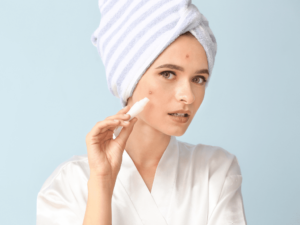Your skincare during summer need extra attention because your skin needs all the sun protection it can get with sunscreen. So, the sunscreen you choose should have a special place in your skincare routine each day. FDA recommends and encourages the usage of these products and recognizes the benefits of a sunblock.
The article below will provide all the information needed to better understand how this skin protection works and how to keep your skin healthy during the hot season.
How does sunscreen work?
Sunscreen prevents sunburns, the itch and the skin peeling that comes after. It is an essential product that creates a barrier for your skin, against damaging sun rays. Sunscreen works by absorbing the UV rays. There is a combination of factors that makes it the right mix against UV radiation. Physical particles contained by the cream reflect these nocive rays. It also features many chemical ingredients that absorb the UV before reaching your skin. These particles absorb and then transform the rays into heat.
If sun protection contains these two factors, it is a good product for UVA and UVB. Both of these types of radiation are highly damaging. Before buying skin protection, it’s good to understand how sunscreen acts on your skin and against what.
UVA rays are responsible for sunburns and skin cancer; therefore, you need to create a strong barrier against them. UVB radiation is another thing you should avoid exposing your skin to. They both cause premature ageing skin and wrinkles.
Why is sunscreen so important?
Sunscreen is very important and during summer, you should add it to your everyday skincare routine. It is proven that it will significantly decrease the risk of cancer. If you use a product with SPF 15, there are 40% fewer chances of getting squamous cell carcinoma (SCC). It also lowers the risk of melanoma by 50%.
Another benefit of wearing sunscreen is that your skin will age slower. The UV rays cause sagginess, colored spots on your face, and wrinkles. You will need to use it on all parts of your body where your skin can be exposed to the sun. Apply it not only to the face if you want to maintain that great aspect.
Some creams, treatments, or skin conditions might raise some problems if you expose yourself to the sun. Add proper protection,and sunblock is just the product you need.

What is the best sunscreen?
Ultra Facial Defense SPF 50 is one of the best lightweight sunblocks that protects against both UVA and UVB radiation. It helps with collagen stimulation and prevents dark-colored spots. It contains minerals, is easily absorbed into your skin and has moisturizing properties.
Will sunscreen stop you from tanning?
First of all, you need to know that tanning is not the healthiest thing for your skin. In fact, it represents the response of your skin to damaging UV sun rays.
As for sunscreen, these creams protect your skin from UV radiation. But they allow a low quantity of light to penetrate the barrier. So even if you apply sunscreen when you stay in the sun, you will get a slight tan. Its purpose is to protect you from unwanted sunburn.
So, if you are wondering if you can tan with an SPF 50 cream, the answer is yes. It will block 98% of radiation, but that 2% UV gets through. So, if you know you have sensitive skin, do not expose yourself at sun peak.
Sunscreen versus sunblock
Is there a difference between sunscreen and sunblock? YES, there is! Sunscreen prevents UV but allows at least 2% of radiation to penetrate the skin and create a tan. Sunblocks are different. They contain special ingredients called titanium dioxide or zinc oxide that completely block sun rays.
This is a better option for people with sensitive skin. Sunblocks contain ingredients that are less likely to irritate the skin.

Are sunscreen sprays effective?
Sunscreen and sunblocks come as creams, oils, sticks, and even sprays. They are all safe and recognized by FDA as effective ways to prevent sun damage. So, if you prefer using a spray instead of a cream, it is totally safe to go for this option.
What to avoid when using sunscreen
When you choose your sunscreen for daily use, you should find a product that does not contain oxybenzone. It is toxic, it can act like estrogen and it disrupts the hormone system.
Another thing you have to keep in mind is that when wearing sunscreen, avoid using retinol or vitamin A.
Combining sunscreen with repellent is not a good idea because it might harm your skin.
Sunscreen to wear under makeup
Sunscreen is most of the time oily or way too creamy. Nobody likes using it under makeup because it makes these products smudge all over the face. Yet, if you want to prevent ageing, wearing it is a must.
With that being said, you will need a suitable product that is lightweight and looks great under your favourite foundation. If you are looking for sun protection, here you can find some of the best sunscreens.
How to apply sunscreen?
Imagine that sunscreen is like a layer of protection. If you want it to be effective and perfectly working, you need to apply the product all over the body.
So, f you want to get full protection, here is what you need to do! First, make sure you don’t miss any spots when applying sunscreen. You need to let it sink into your skin. After that, apply the second layer. The product will not fill all these lines, so it is ideal to do it twice.
Apply the product at least 15-20 minutes before you expose yourself to sun rays.
Most people tend to forget about certain areas of the body when using sunscreen, so make sure you spread the sunscreen on your ears, chest, nape, or even bald patches.
Another thing that is considered a must when using sunscreen is the frequency of application. So, applying the product every two hours is ideal. But, if you go in and out of the water, you should certainly use it after drying your skin.
What is SPF?
SPF, also known as Sun Factor Protection, is a number you can find on most sunscreens and sunblocks. That number DOES NOT indicate the number of minutes you can stay in the sun after applying the product. Instead, it shows how well the sunscreen will protect your skin against UV. It shows how much longer it takes untanned skin to start to become red with the product applied, compared to how long it takes your skin to get red without it.
For example, it takes 500 seconds for the skin to burn without any protection applied and 10 seconds without. Specialists divide 500 by 10 and get 50 – the SPF for the sunscreen.
Conclusions
Using sunscreen should be part of your everyday skincare routine. Choose a product that suits your skin type and apply it each time you expose your skin to sun rays.






